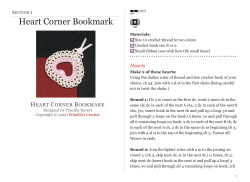
( )
STEP 5 (THROUGH) You now have two loops on the hook and the thread is wrapped around the hook. Pull the wrapped thread through both loops. NOTE: YOU CAN PULL THE WRAPPED BASIC TUBULAR BEAD CROCHET You’ll need #10 perle cotton, three different colors of size 8o seed beads, a threading needle and a size #9 or 10 steel crochet hook. Getting started Wind your thread onto a card with two holes, one each at the top and bottom. Thread beads onto your fiber in the ABC pattern, repeating until you have about 60” of beads on the thread. Do not cut or knot the thread, but wind it back onto the card. After threading on the beads, make a slip knot on the hook. Thread wound onto the winding card After making the slip knot, make six chain stitches, each with one bead THREAD THROUGH ONE LOOP AT A TIME, USING TWO MOTIONS TO COMPLETE THIS STEP, UNTIL YOU ARE COMFORTABLE PULLING THE WRAPPED THREAD THROUGH BOTH LOOPS. This completes the stitch. Repeat the five numbered steps until you have six completed stitches. Photo A shows an overhead view of the first round completed. Photo B shows the tube as you progress. B A Flatten the work; from overhead, you should already see six “spokes” of thread. At the end of each spoke is one bead. Note that the next beaded stitch into which you will insert the hook has a pink bead, which is the color of the next bead you will slide down the thread. You will know that you are working correctly if this happens consistently. Position the hook in a loop of thread as shown in the photos and pull so the slip knot forms on the hook. To chain with a bead, slide a bead down the thread until it hangs below the hook. Wrap the thread around the hook and pull it through the loop. Every stitch you make after the foundation chain consist of five distinct steps: IN, OVER, DOWN, AROUND, and THROUGH. STEP 1 (IN) Insert the hook into the first beaded chain. Don’t pierce the thread with your hook or put the hook through the hole in the bead. STEP 2 (OVER) Slide the bead over to the far side of the hook. This is an important step; in order for the whole process to be successful, all the beads must “land” on the outside of the tube. The act of pushing the bead over the hook forces it to the outside of the tube that will develop. Seen from the side (photo B), the beads will show a clear spiral pattern even at this early stage. Note that the lower beads (those of the original six chains) are positioned horizontally, while the beads of the new round are somewhat vertical. This will happen consistently if you are working correctly. As the tube lengthens, the spiral pattern will become more visible, and the relative positioning of the beads (horizontal, vertical) will be more pronounced. Troubleshooting common problems You don’t have six beads in the round you are working on. The thread is positioned to the right of the bead that was passed over the hook STEP 3 (DOWN) Bring a bead down the thread as shown above. The thread MUST be positioned to the right of the bead that has been passed over the hook in step 2 (OVER). If not, the stitch will fail because the bead you just pushed to the far side of the hook will be forced back to the front again. STEP 4 (AROUND) Wrap the thread around the hook from back to front (toward yourself) so the new bead and the bead that has been passed over the hook are touching. The new thread will cross over the loop that’s on the hook. The bead that you slide down the thread will be the same color as the bead you just moved to the far side of the tube. This will happen with each new “pair” of beads, the one you have already crocheted, and the one you slide down the thread. This can easily happen, especially if you’re working in only one color. After every few rounds, check your tube to be sure you have six beads around the spokes when you flatten the top. If you see a different number, pull out the work until you have six. You have either missed one stitch or placed more than one bead into a stitch. If you’re working in a spiral pattern (ABC), remember that the bead you bring down the thread should be the same color as the bead you pushed over the hook. A bead appears in the center of your tube If you look at the side of the tube, one bead seems to be receding. If you look at the top of the tube, a bead is in the center of the spokes. This means that the bead you moved to the far side of the hook has slipped through as you pull the thread through the loops. If this happens, you can either push the bead back out again, or, if that is too difficult, pull out stitches until your work looks correct again. It may also mean that your wrapped thread did not come from the right of the bead on the hook. A FREE VIDEO TUTORIAL FOR TUBULAR BEAD CROCHET CAN BE FOUND AT OUR WEB SITE WWW.BEADSEAST.COM OR AT OUR YOUTUBE CHANNEL ©2005, 2012 Ann Benson, all rights reserved. This material is intended for the private use of one individual only. Teachers wishing to use this material may do so after obtaining express written permission, and agreeing that the content of this material including corporate identity will remain intact and unchanged. DVDs of the video content are available for low cost purchase to teachers upon request. No commercial use or non-instructional sale is permitted under any circumstances.
© Copyright 2025


















